
About Athletics
Athletics, also known as track and field, is a sport that encompasses a wide range of events, showcasing the pinnacle of human physical capabilities and sporting prowess. From lightning-fast sprints to powerful throws and breathtaking jumps, athletics captivates spectators around the world with its raw athleticism, determination, and extraordinary feats of performance.
Athletics is the most followed track and field events in the world. Athletics is a broader category of many events, for both men and women. Governed by International Amateur Athletic Federation (IAAF), that was established as the world governing body for the sport of track and field athletics. In 2019 the name of International Amateur Athletic Federation (IAAF) was changed to World Athletics.
Apart from governing all the athletics events, they are also responsible for standardization of rules of the sport, maintaining world records and sanctioning of various athletics events throughout the world.
Men and women athletes participate separately in their categories for these events.
Athletics Olympic 2020 logo : ![]()
Events In Athletics
History
Track and field event is the oldest sporting completion that highlights the stamina and endurance of athletes in different categories. The scope of the events expanded gradually over the period, more events were introduced under this broader category of athletics.
Beginning of Olympics gave a major boost to athletics. Track and field events and marathon were part of the Olympics since its inception in 1896. On 17 July 1912 in Stockholm, Sweden, following the closing ceremony of the Olympic Games in the Swedish capital, the International Amateur Athletic Federation (IAAF) was founded to govern the world athletics.
Objective
Athletics is a sport of stamina and endurance that requires hard work, consistent training, physical workouts and thoughtful diets. Athletes compete with each other to win the event they are participating following all the rules laid down for the event.
This event demands a unique blend of physical attributes and skills from its athletes. Sprinters need explosive speed, power, and impeccable technique to cover short distances in a matter of seconds. Long-distance runners must possess exceptional endurance and stamina to maintain a fast pace over extended periods.
Jumpers and throwers require explosive strength, agility, and coordination to propel themselves or an object to great heights or distances. The sport celebrates the diverse range of human physical capabilities and pushes athletes to reach their limits.
Success in athletics is built on a foundation of rigorous training, discipline, and dedication. Athletes devote countless hours to conditioning their bodies, honing their technique, and improving their speed, strength, and agility.
Training programs vary depending on the discipline, with athletes focusing on specific aspects such as speed work, endurance training, weightlifting, and plyometrics. Mental preparation is equally important, as athletes must cultivate focus, determination, and resilience to excel in the face of intense competition.
Races and marathon events depend upon the best time achieved by the winning athlete while events like high jumps and pole vault depend upon the best height jumped by the athlete.
Events like long jump and triple jumps track the best distance jumped by the athletes and events like throws track the athletes based on the distance of the throws.
Events like Decathlon for men and Heptathlon for women follows a points system as they involve multiple events and here athletes need to score the maximum number of points to succeed.
Athletics takes center stage in prestigious competitions such as the Olympic Games, World Championships, and regional championships. These events bring together the world’s best athletes, representing their countries and striving for glory on the international stage.
The atmosphere is electric, with spectators witnessing displays of athleticism, sportsmanship, and fierce competition. Athletics transcends borders and cultures, uniting people from all walks of life in a shared celebration of human achievement.
General Rules
- Qualified athletes are provided with a bib and hip number which the athletes should wear in their shirts and shorts exposing the number thus making the identification of the athletes visible.
- Only three athletes of a country can participate for an event on the condition that they have all qualified the entry standard for the event.
- The country can enter a reserved athlete for an event in case of injury to any athlete on the condition that this reserved athlete has also qualified the entry standard for the event. This exception is not imposed for relays.
- Athletes of the team shall wear the same colour competition uniform during the competition and in all ceremonies.
- Athletes should strictly adhere to anti-doping rules.
100-meter sprint is a short-distance race in which runners compete based on speed and acceleration and applies for both men and women. This race is run in the home straight of the 400m track.
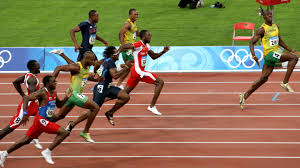
Rules of 100 m Race
- The athlete should have both the legs in the starting blocks and their body should be behind the starting line once the official gives the set command.
- Athletes are allowed to wear spiked shoes for grip.
- The athlete may be disqualified due to a false start where an athlete leaves the starting block in less than 0.12 seconds after the gun had fired. This is the amount of time required by the brain to process the information heard by the ear.
- An athlete who leaves the allocated lane or obstructs other athlete is disqualified.
- Stepping on the line of the lanes is also ruled as leaving the lane. The referee takes the final decision based on the amount of infringement.
- Time for completion of the race is recorded based on the trunk of the body of the athlete crossed the finishing line.
World Records of 100 m Race
- 100 m Mens
- 9.58 s set by Usain Bolt in 2009

- 100 m Womens
- 10.49 s set by Florence Griffith-Joyner in 1988

200-meter sprint is also considered a short-distance race in which runners compete based on speed and acceleration and applies for both men and women. The athletes have to traverse a curve and run on a straight path. This race is run in an oval path and the home straight of the 400m track.
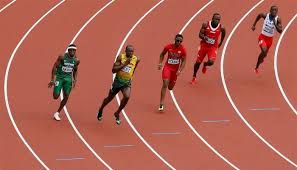
Rules of 200 m Race
- The race is run in a staggered formation with the athlete in the outer ring placed ahead of the athletes of the inner rings.
- The athlete should have both the legs in the starting blocks and their body should be behind the starting line once the official gives the set command.
- Athletes are allowed to wear spiked shoes for grip.
- The athlete may be disqualified due to a false start where an athlete leaves the starting block in less than 0.12 seconds after the gun had fired. This is the amount of time required by the brain to process the information heard by the ear.
- An athlete who leaves the allocated lane or obstructs other athlete is disqualified.
- Stepping on the line of the lanes is also ruled as leaving the lane. The referee takes the final decision based on the amount of infringement.
- Time for completion of the race is recorded based on the trunk of the body of the athlete crossed the finishing line.
World Records of 200 m Race
- 200 m Mens
- 19.19 s set by Usain Bolt in 2009

- 200 m Womens
- 21.34 s set by Florence Griffith-Joyner in 1988

400-meter sprint is also a short-distance race in which athletes compete based on individual speed and stamina and applies for both men and women. The athletes have to traverse the race circuit of the circumference of 400m once.

Rules of 400 m Race
- The race is run in a staggered formation with the athlete in the outer ring placed ahead of the athletes of the inner rings.
- The athlete should have both the legs in the starting blocks and their body should be behind the starting line once the official gives the set command.
- Athletes are allowed to wear spiked shoes for grip.
- An athlete making a false start gets a warning; athlete can be disqualified on repeating the same mistake.
- An athlete who leaves the allocated lane or obstructs other athlete is disqualified.
- Stepping on the line of the lanes is also ruled as leaving the lane. The referee takes the final decision based on the amount of infringement.
- Time for completion of the race is recorded based on the trunk of the body of the athlete crossed the finishing line.
World Records of 400 m Race
- 400 m Mens
- 43.03 s set by Wayde van Niekerk in 2016

- 400 m Womens
- 47.60 s set by Marita Koch in 1985

800-meter sprint is the beginning of mid-distance race in which runners compete based on individual speed and stamina and applies for both men and women.
The athletes have to traverse the race circuit of the circumference of 400m twice or thrice depending upon the distance. They are informed with a bell indicating the last round of their sprint.
800m race is run in a staggered formation with the athlete in the outer ring placed ahead of the athletes of the inner rings. In 1,500m athletes are bunched in two groups, they start the race behind two arced starting lines.
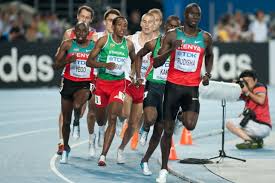
Rules of 800 m and 1,500 m Race
- Athletes are allowed to break in after the first turn.
- Athletes are allowed to wear spiked shoes for grip.
- An athlete making a false start gets a warning; athlete can be disqualified on repeating the same mistake.
- Athlete is not allowed to touch the innermost lane with either leg or hand.
- An athlete who obstructs other athlete is disqualified.
- Time for completion of the race is recorded based on the trunk of the body of the athlete crossed the finishing line.
- Athletes may leave the racing track voluntarily before the race ends. They are disqualified automatically.
World Records of 800 m and 1,500 m Race
- 800 m Mens
- 1 min 40.91 s set by David Rudisha in 2016

- 800 m Womens
- 1 min 53.28 s set by Jarmila kratochvílová in 1983

- 1500 m Mens
- 3 min 26.00 s set by Hicham El Guerrouj in 1998

- 1500 m Womens
- 3 min 50.07 s set by Genzebe Dibaba in 2015

These are long-distance races in which athletes compete based on individual speed and stamina and applies for both men and women. The athletes have to traverse about 12-and-a-half laps of the race circuit of the circumference of 400m for 5,000 m and 25 laps for 10,000m.
The athletes are informed with a bell indicating the last round of their sprint. Athletes are bunched in two groups; they start the race behind two arced starting lines separated from each other. They are allowed to bunch in after the start.
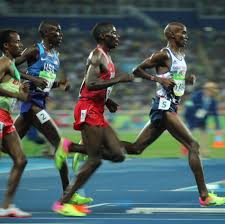
Rules of 5,000 m and 10,000 m Race
- Athletes are allowed to wear spiked shoes for grip.
- An athlete making a false start gets a warning; athlete can be disqualified on repeating the same mistake.
- Athlete is not allowed to touch the innermost lane with either leg or hand.
- An athlete who obstructs other athlete is disqualified.
- Time for completion of the race is recorded based on the trunk of the body of the athlete crossed the finishing line.
- Athletes may leave the racing track voluntarily before the race ends. They are disqualified automatically.
World Records of 5,000 m and 10,000 m Race
- 5000 m Mens
- 12 min 37.35 s set by Kenenisa Bekele in 2004

- 5000 m Womens
- 14 min 11.15 s set by Tirunesh Dibaba in 2008

- 10000 m Mens
- 26 min 17.53 s set by Kenenisa Bekele in 2005

- 10000 m Womens
- 29 min 17.45 s set by Almaz Ayana in 2016

Marathon is a long-distance race covering about 42.195 kilometres and applies for both men and women. They are run in the countryside and finally, the path leads to a prominent place or the designated stadium for the final lap.
The path of the marathon is easily identifiable with proper markings and signboards. They are also provided hydrated drinks in their path.
An athlete who obstructs other athlete is disqualified. Distance covered is not displayed to the athlete during their race and they can quit the race at any time making them disqualified.
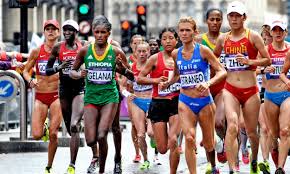
World Records of Marathon
- Marathon Mens
- 2 hours 01 min 39 s set by Eliud Kipchoge in 2018

- Marathon Womens
- 2 hours 14 min 04 s set by Brigid Kosgei in 2019

110m hurdles is a hurdling event where ten hurdles are placed evenly on the tracks. For men, the total distance is of 110m while for women the distance of this race is 100m.
The first hurdle is placed about 45 ft from the starting line. Hurdles have a height of 42 inches each and are designed to fall over if bumped by the athlete.
The fallen hurdles do not carry any penalty for the athlete but they make the athlete slower and hence affect the finishing position of the athlete.
Athletes are required to leap over the hurdles and complete the race. This race is run in the home straight of the 400m track.
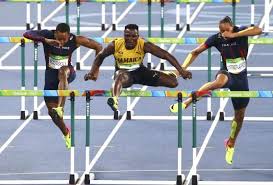
Rules of 110 m Hurdles Race
- The athlete should have both the legs in the starting blocks and their body should be behind the starting line once the official gives the set command.
- Athletes are allowed to wear spiked shoes for grip.
- The athlete may be disqualified due to a false start where an athlete leaves the starting block in less than 0.12 seconds after the gun had fired. This is the amount of time required by the brain to process the information heard by the ear.
- An athlete who leaves the allocated lane or obstructs other athlete is disqualified.
- Athletes are disqualified, if they deliberately know down hurdles. Accidental knockdown of hurdles does not attract any penalty.
- Stepping on the line of the lanes is also ruled as leaving the lane. The referee takes the final decision based on the amount of infringement.
- Time for completion of the race is recorded based on the trunk of the body of the athlete crossed the finishing line.
World Records of 110 m Hurdles Race
- 110 m Hurdles Mens
- 12.80 s set by Aries Merritt in 2011

- 100 m Hurdles Womens
- 12.20 s set by Kendra Harrison in 2016

3000 m steeplechase is a mid-distance hurdled race both for men and women athlete. This event has four barriers and a water jump. Unlike the hurdles race, the hurdles placed for steeplechase are hard and do not fall. The height of the hurdles is 36 inches for men and 30 inches for women.
The water jump landing area is 12 ft. and is 70 cm deep preceded by a hurdle. Athletes can step on the hurdles during their race. They have to overcome 28 hurdles and 7 water jumps during their entire race. They are informed with a bell indicating the last round of their sprint.
Athletes are bunched in two groups; they start the race behind two arced starting lines separated from each other. They are allowed to bunch in after the start.
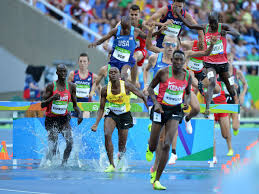
Rules of 3,000 m Steeplechase
- Athletes are allowed to wear spiked shoes for grip.
- An athlete making a false start gets a warning; athlete can be disqualified on repeating the same mistake.
- Athlete is not allowed to touch the innermost lane with either leg or hand.
- An athlete who obstructs other athlete is disqualified.
- Time for completion of the race is recorded based on the trunk of the body of the athlete crossed the finishing line.
- Athletes may leave the racing track voluntarily before the race ends. They are disqualified automatically.
World Records of 3,000 m Steeplechase
- 3000 m Steeplechase Mens
- 7min 53.63s by Saif Saaeed Shaheen 2004

- 3000 m Steeplechase Womens
- 8 min 44.32s by Beatrice Chepkoech in 2018

20 km and 50 km are long-distance fast walking race, where one foot must always be in contact with the ground at all times and applies for both men and women. The position of the foot is always decided by judges and any infringement may lead to disqualification.
This is a road event and culminates on a prominent landmark or organising stadium. Athletes are allowed to take hydrated drinks during their course of the race walk.
Distance covered is not displayed to the athlete during their race walk and they can quit the race at any time making them disqualified.
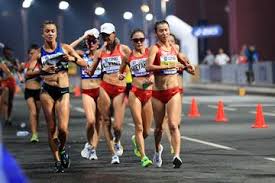
World Records of 20 and 50 Kms Race Walk
- 20 km Walk Men
- 1 hour 16 min 36 s by Yusuke Suzuki in 2015

- 20 km Walk Women
- 1 hour 24 min 38 s by Hong Liu in 2015

- 50 km Walk Men
- 3 hour 32 min 33 s by Yohann Diniz in 2014

- 50 km Walk Women
- 3 hour 59 min 15 s by Hong Liu in 2019

High Jump is an event where the athlete needs to jump over a crossbar of 4 feet in length and applies for both men and women. The height of the crossbar is decided by the judge. This event includes a jumping area that is 15m long.
An athlete may use any technique to cross over the bar without dislodging it. A crash mat is provided for athletes and they should land in the crash mat.

Rules of High Jump
- Athlete shoes can have a maximum thickness of 13mm with the thickness of heels at maximum 19mm. Spikes are not allowed in the shoes.
- An athlete should take off on one foot.
- Dislodging the bar by any portion of the athlete’s body or shoe is considered as an unsuccessful attempt.
- An athlete is required to cross the height in three consecutive jumps to reach the next level failing which athlete is disqualified.
- The athlete whosoever clears the bar with the highest height is declared as the winner.
- Only twelve athletes are allowed to compete for the finals.
- In case of a tie, the athlete crossing the bar with fewer misses is declared as the winner.
- For deciding the first place the athlete’s face-off for a tie, with the bar raised to a new height and athlete has only one chance to clear the bar.
World Records of High Jump
- High Jump Mens
- 2.45 m set by Javier Sotomayor in 1993

- High Jump Womens
- 2.09 m set by Stefka Kostadinova in 1987

Pole vault requires an athlete to clear a crossbar with the help of a pole usually made of strong fibreglass and applies for both men and women. Athlete sprint over with a pole of 4.5m and jams it against a designated hole inside a metal box that is placed centrally.
They intend to clear the greatest height set by the judges. The coach must mention the weight of the athlete beside the name of the athlete. A crash mat is provided for athletes and they should land in the crash mat.
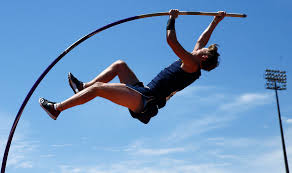
Rules of Pole Vault
- Three chances are offered to an athlete to clear the designated height, failing which the athlete is disqualified.
- Athletes are required to take the second attempt immediately after the first attempt and the third attempt after the second attempt if they fail to clear the height in their second attempt.
- An athlete can pass the height of his attempt. It should be communicated to the judge after the miss.
- An athlete must complete the jump within two minutes of the name being called.
- No taping is allowed in the figures of the athletes unless the athlete carries injury. Applying tape in wrists is permitted.
- Applying chalks or resins are allowed to be applied in the hand.
- An athlete using shoes providing them with an unfair advantage is prohibited.
- In case of a tie, the athlete with the lowest number of unsuccessful attempts is declared as the winner.
- For deciding the first place the athlete’s face-off for a tie, with the bar raised to a new height and athlete has only one chance to clear the bar.
World Records of Pole Vault
- Pole Vault Men
- 6.17 m by Armand Duplantis in 2020

- Pole Vault Women
- 5.06 m by Yelena Isinbayeva in 2009

Long jump requires athletes to jump over a distance after taking off in one foot and landing in a sandpit and applies for both men and women. Athlete sprints over a runway 40 m long and his front of the foot should not touch the takeoff board line.
Distance covered in the jump is measured from the forward edge of the takeoff board to the last impression made by the athlete on the sand. The width of the sandpit is 3m.

Rules of Long Jump
- Athlete must initiate the jump using one foot.
- Athlete’s shoe can have a maximum thickness of 13 mm; spikes are allowed in the shoe.
- Athlete must complete the jump within one minute of his name being called.
- Athletes are allowed three jumps and must set distance of the jump within these three attempts. In the case of three failed attempt athlete are disqualified.
- Athlete elevated to top eight based on their distance set receive three more attempts.
- The longest single jump during the final wins. If two jumpers are tied, the jumper with the longer second-best jump is awarded the medal.
- The speed of the wind plays an important factor, Jumps executed with a tailwind or more than two meters per second don't count.
- Athletes can use markers to mark up their starting run. Only two markers are provided for athletes.
- Any part of athlete’s foot touches the takeoff board line is considered as a failed attempt. Judge raises a red flag for that attempt. The judges raise a green flag for a valid attempt.
World Records of Long Jump
- Long Jump Men
- 8.95m by Mike Powell in 1991

- Long Jump Women
- 7.52 m by Galina Chistyakova in 1988

Triple jump requires an athlete to jump over a distance using hop, step and jump method and landing in the sandpit and applies for both men and women.
Athlete sprints over a runway, and jumps with one foot without touching the takeoff line, then hops to the next foot to initiate the step phase followed by the jump phase. All this phase should be done in one continuous motion. The width of the sandpit is 3m.
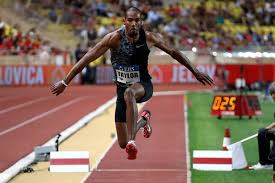
Rules of Triple Jump
- Athlete’s shoe can have a maximum thickness of 13 mm; spikes are allowed in the shoe.
- Athlete must complete the jump within one minute of his name being called.
- Athletes are allowed three jumps and must set distance of the jump within these three attempts. In the case of three failed attempt athlete are disqualified.
- Athlete elevated to top eight based on their distance set receive three more attempts.
- The longest single jump during the final wins. If two jumpers are tied, the jumper with the longer second-best jump is awarded the medal.
- The speed of the wind plays an important factor, Jumps executed with a tailwind or more than two meters per second don't count.
- Athletes can use markers to mark up their starting run. Only two markers are provided for athletes.
- Judges found that there is a violation of hop, step and jump technique, the attempt is considered as a failed attempt.
- Any part of athlete’s foot touches the takeoff board line is considered as a failed attempt. Judge raises a red flag for that attempt. The judges raise a green flag for a valid attempt.
World Records of Triple Jump
- Triple Jump Men
- 18.29 m by Jonathan Edwards in 1995

- Long Jump Women
- 15.50 m by Inessa Kravets in 1995

Shot put involves throwing of a put ball which weighs 7.260 kg for men and 4 kg for women and is made of cast iron or brass. Athletes use different techniques for releasing the put.
The glide and spin are two commonly used techniques. The legal sector of the throwing area is 34.92 degrees and the put should always land in that area to be counted as a legitimate throw.
The shot put circle is 2.135m in diameter and has a toe board at the front that is 10 cm high. The objective is to throw the ball as far as possible. The athlete throwing the put to the greatest distance wins the event.

Rules of Shot Put
- An athlete has 60 s to complete the throw after their name gets called.
- Athlete can touch the inner area of the toe board but should never touch the upper area of the toe board.
- Athlete cannot touch the ground outside the circle, and cannot leave the throwing circle until the throw hits the ground.
- Athlete must use only one hand, and shot should be released above the athlete’s shoulder height.
- Though athletes are allowed to enter the throwing circle from anywhere, they must leave the circle after the put hits the ground always from the backside.
- Athletes must never wear gloves but are allowed to use finger tapes for protection.
- The put ball should be in contact with the athlete’s neck during the entire spinning motion.
- The shot put should land on the legal throwing area of 34.92 degrees marked for landing.
- Each athlete is allocated three throws to produce their best throw. Athletes proceeding to the next stage are provided three more throws to prove their ability.
World Records of Shot Put
- Short Put Men
- 23.12m by Randy Barnes in 1990

- Short Put Women
- 22.63 m by Natalia Lisovskaya in 1987

Discus throw involves throwing of a discus weighing 2 kg for men and 1 kg for women made from wooden or synthetic material surrounded by a metal rim.
The discus should be similar from all sides and should not contain any edges. The legal sector of the throwing area is 34.92 degrees but is longer and the discus should always land in that area to be counted as a legitimate throw.
The circle is 2.135m in diameter and has a toe board at the front that is 10 cm high. The objective is to throw the discus as far as possible.
The athlete throwing the discus to the greatest distance wins the event. The throwing circle is surrounded by a “U” shaped cage to protect other athletes and officials in case of an erroneous throw.
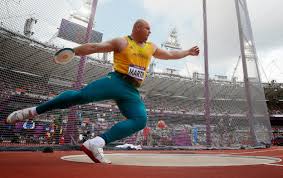
Rules of Discus Throw
- An athlete can touch the inner area of the toe board but should never touch the upper area of the toe board.
- An athlete cannot touch the ground outside the circle, and cannot leave the throwing circle until the discus hits the ground.
- The athlete must use only one hand for throwing the discus, and it should be released above the athlete’s shoulder height.
- Though athlete is allowed to enter the throwing circle from anywhere, they must leave the circle after the discus hits the ground always from the backside.
- Athletes must never wear gloves but are allowed to use chalk in their hands for grip.
- The discus should land on the legal throwing area of 34.92 degrees marked for landing.
- Each athlete is allocated eight throws to produce their best throw.
World Records of Discus Throw
- Discuss Throw Men
- 74.08m by Jürgen Schult in 1986

- Discuss Throw Women
- 76.80 m by Gabriele Reinsch in 1988

Hammer throw involves throwing a hammer ball tied to steel wire to the maximum distance. The weight of the spherical hammer ball is 7.26 kg for men and 4 kg for women.
The length of the steel wire should exceed 121.5 cm. The steel wire is provided with a handle that is used by the athletes to grab the hammer ball.
Hammer throw is done from a circle having a diameter of 2.135m. A cage is provided around the hammer throw arena for the safety of officials and spectators. An athlete uses the swing technique to achieve the speed then fling the hammer in a tangential path to achieve the maximum distance.

Rules of Hammer Throw
- Athletes are allowed to wear gloves.
- Each athlete is provided with three chances to post their best throw. Only 12 athletes take part in the final competition. Athletes qualifying in the round of 8 are provided three more chances to register their best throw.
- The longest single throw by an athlete wins the competition.
- Athletes are allowed to touch the hammer with the ground of the circle. But once the athlete starts the preliminary swing they are not allowed to touch the hammer with the ground.
- In case the hammer breaks from the attached wire during the swing, it is not considered as a foul.
- Athletes are allowed to use both their hands during the swinging of the hammer.
- An athlete cannot touch the ground outside the circle, and cannot leave the throwing circle until the hammer hits the ground.
- The athlete can touch the inner area of the toe board but should never touch the upper area of the toe board.
World Records of Hammer Throw
- Hammer Throw Men
- 86.74m by Yuriy Sedykh in 1986

- Hammer Throw Women
- 82.98 m by Anita Wlodarczyk in 2016

Javelin throw involves a javelin that is 2.7m long for men and 2.3m long for women. Men’s javelin weighs 1.8 pounds while women’s javelin weighs 1.3 pounds. The longest thrower of the javelin wins the event.
The athlete has a 36.5m long runway to get the momentum for throwing. Javelin should land within the arc marked for the landing.
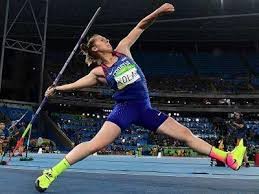
Rules of Javelin Throw
- Athletes are allowed to wear spikes.
- Athletes should release the javelin using one hand.
- Athletes should hold the javelin at the designated point with the pointed end facing the ground.
- Athletes should always hold the javelin above their shoulder level.
- Athletes must throw the javelin from within the designated throw line.
- The javelin should land with tip first for considering as a valid throw and within the designated arc in the ground.
- Use of gloves or finger tapes is prohibited unless the athlete has a wound.
- An athlete should remain with the designated area of throw until the javelin lands.
- An athlete should not touch the area outside the designated runway area during their throw.
- An athlete cannot turn their back to the field until the javelin lands on the ground.
World Records of Javelin Throw
- Javelin Throw Men
- 98.48m by Jan ŽELEZNÝ in 1996

- Javelin Throw Women
- 80.00 m by Petra Felke in 2018

Decathlon is a men’s event where athlete participates in 10 events of athletics. This event is spread over two consecutive days and adheres to the rules and regulation of different events mentioned previously.
The athletes here gather points based on their position of finish in each of the events. The athlete with the highest points earned wins the event. The athlete winning the decathlon event is considered to be the most complete men athlete.
Decathlon Events
Click on the events to learn their rules of events
Rules of Decathlon
- Each athlete is allowed three attempts for Discus Throw, Pole Vault, Javelin Throw, Shot put and Long Jump.
- An interval of 30 minutes is provided to the athletes in between events.
- In case an athlete committing foul on another athlete in any event, the athlete loses points gained for that event but shall be allowed to compete for other events unless referee decides otherwise depending upon the intensity of the committed foul.
- Athletes must attempt each event. This rule is designed to guarantee that the athlete intends to do a 'decathlon' and not just set records or get a workout in single events. Athletes failing to start any event are considered to have abandoned the competition, receive no final score and are not included in the final placing.
- Individual and cumulative scores of the athletes will be informed to them after the conclusion of every event.
- The starting bar height for high jump and pole vault are determined by the referee and is not dependent on athletes. The starting height of the bar will be announced to athletes well before time.
World Records of Decathlon
- Decathlon
- Kevin Mayer set 9126 points

Heptathlon is a women’s event where athlete participates in 7 events of athletics. This event is spread over two consecutive days and adheres to the rules and regulation of different events mentioned previously.
The athletes here gather points based on their position of finish in each of the events. The athlete with the highest points earned wins the event. The athlete winning the heptathlon event is considered to be the most complete women athlete.
Heptathlon Events
Click on the events to learn their rules of events
Rules of Heptathlon
- Each athlete is allowed three attempts for Javelin Throw, Shot put and Long Jump.
- An interval of 30 minutes is provided to the athletes in between events.
- In case of an athlete committing foul on another athlete in any event, the athlete looses points gained for that event but shall be allowed to compete other events unless referee decides otherwise depending upon the intensity of the committed foul.
- Athletes must attempt each event. This rule is designed to guarantee that the athlete intends to do a 'decathlon' and not just set records or get a workout in single events. Athletes failing to start any event are considered to have abandoned the competition, receive no final score and are not included in the final placing.
- Individual and cumulative scores of the athletes will be informed to them after the conclusion of every event.
- The starting bar height for high jump and pole vault are determined by the referee and is not dependent on athletes. The starting height of the bar will be announced to athletes well before time.
World Records of Heptathlon
- Heptathlon
- Jackie Joyner-Kersee set 7291 points in 1988

4x100m relay is a relay race that involves passing the baton to the next athlete and completing the race with the baton in minimum time and applies to both men and women.
As the name of the event suggests, this involves 4 athletes each running a distance of 100m with a baton in hand. After each 100m they pass over the baton to their fellow athlete, that athlete then passes the baton to the next and so on.
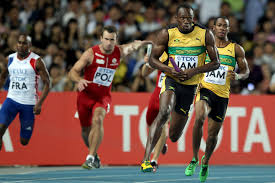
Rules of 4x100 m Relay
- Athletes are arranged in a staggered formation, where each athlete starts from a different position in the lanes from the starting blocks. So, they all cover the equal distance.
- Each member of a relay team can run one leg only.
- The baton should be carried throughout the race by the athletes.
- Baton, if dropped, shall be recovered by the athlete who dropped it. He may leave his lane to retrieve the baton provided that, by doing so, he does not lessen the distance to be covered. When the baton is dropped in such a way that it moves sideways or forward in the direction of running (including beyond the finish line), the athlete who dropped it, after retrieving it, must return at least to the point where it was last in his hand, before continuing in the race.
- The athlete should pass over the baton to a fellow athlete within 20 m changeover box. In case any of the athletes fail to pass the baton within this changeover box is considered as foul and the team is disqualified.
- An athlete should have both the legs in the starting blocks and their body should be behind the starting line once the official gives the set command.
- Athletes are allowed to wear spiked shoes for grip.
- An athlete may be disqualified due to a false start where an athlete leaves the starting block in less than 0.12 seconds after the gun had fired. This is the amount of time required by the brain to process the information heard by the ear.
- An athlete who leaves the allocated lane or obstructs other athlete is disqualified.
- Stepping on the line of the lanes is also ruled as leaving the lane. The referee takes the final decision based on the amount of infringement.
- Time for completion of the race is recorded based on when the trunk of the body of the athlete crossed the finishing line.
World Records of 4x100 m Relay
- 4 X 100 m Relay Men
- 36.84s set by team Jamaica on 2012

- 4 X 100 m Relay Women
- 40.82 set by team USA on 2012

4x400m relay is a relay race that involves passing the baton to the next athlete and completing the race with the baton in minimum time and applies to both men and women.
As the name of the event suggests, this involves 4 athletes each running a distance of 400m with a baton in hand. After each 400m they pass over the baton to their fellow athlete, that athlete then passes the baton to the next and so on.
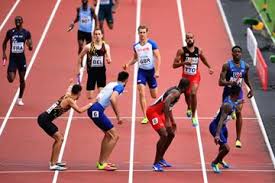
Rules of 4x400 m Relay
- Athletes are arranged in a staggered formation, where each athlete starts from a different position in the lanes from the starting blocks. So, they all cover the equal distance.
- Each member of a relay team can run one leg only.
- The baton should be carried throughout the race by the athletes.
- Baton, if dropped, shall be recovered by the athlete who dropped it. He may leave his lane to retrieve the baton provided that, by doing so, he does not lessen the distance to be covered. When the baton is dropped in such a way that it moves sideways or forward in the direction of running (including beyond the finish line), the athlete who dropped it, after retrieving it, must return at least to the point where it was last in his hand, before continuing in the race.
- The athlete should pass over the baton to a fellow athlete within 20 m changeover box. In case any of the athletes fail to pass the baton within this changeover box is considered as foul and the team is disqualified.
- After the first lap of the race is finished by the athlete, the athlete for the second leg can stand in a straight line.
- An athlete should have both the legs in the starting blocks and their body should be behind the starting line once the official gives the set command.
- Athletes are allowed to wear spiked shoes for grip.
- An athlete may be disqualified due to a false start where an athlete leaves the starting block in less than 0.12 seconds after the gun had fired. This is the amount of time required by the brain to process the information heard by the ear.
- An athlete who leaves the allocated lane or obstructs other athlete is disqualified.
- Stepping on the line of the lanes is also ruled as leaving the lane. The referee takes the final decision based on the amount of infringement.
- Race is run in lanes for the first leg, as well as that part of the second leg up to the first bend.
- Time for completion of the race is recorded based on when the trunk of the body of the athlete crossed the finishing line.
World Records of 4x400m Relay
- 4 X 400 m Relay Men
- 2 mins 54.29 s set by team USA on 1993

- 4 X 400 m Relay Women
- 3 mins 15.17 s set by team Russia on 1988





 (1 votes, average: 5.00 out of 5)
(1 votes, average: 5.00 out of 5)


